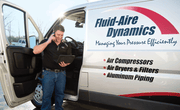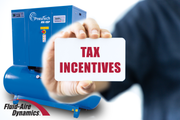We spend a lot of time visiting manufacturers and talking to them about their industrial compressed air systems. Over the years of being a trusted provider of wholesale air compressors and other industrial equipment, we’ve come to realize that there are a lot of misconceptions about compressed air. If you believe any of the compressed air myths below, you could be losing a lot more money than you realize.
Myth #1: Compressed air is free!
Well, you might not think compressed air is free, exactly, but you may not realize exactly how much it costs. Compressed air is the “fourth utility” for manufacturers, right up there with electricity, gas and water. And for most manufacturers, it is by far the most expensive. It takes about 8 HP of electricity to make 1 HP of compressed air. In fact, energy use makes up about 80% of the total lifetime costs for your compressed air system.
That means wasting air is a much bigger deal than leaving a few extra lights on. But because compressed air is made on-site and feels limitless, workers often treat it as a free resource, like the air we breathe. In an average shop, about 30% of compressed air waste, either through leaks or through careless use (like using air to clean the floor instead of picking up a broom). Tightening up compressed air use and getting a handle on hidden leaks can add up to big energy savings.
Myth #2: Bigger is better.
We see this All. The. Time. Many manufacturers believe it’s a good idea to oversize their air compressor. They may be worried about their ability to meet peak demand, or they may be anticipating expanded production in the future. If you can afford the larger compressor, you should go for it, right?
Not necessarily. It rarely pays off to oversize your compressor. Remember what we said about energy making up 80% of your total lifetime costs for an air compressor? Well, the larger the compressor, the more energy it uses. If you install a 50 HP compressor when you only need 25 HP, that can add up to thousands of dollars of wasted energy every year. If your demand is highly variable, a Variable Speed Drive (VSD) motor can reduce energy costs by ramping down the motor speed when demand is low. But even with VSD, it usually doesn’t make sense to purchase a compressor oversized for your peak demand. It may be cheaper to add a small auxiliary backup compressor for infrequent high-demand shifts, or get a larger air receiver tank to handle short high-demand events.
Myth #3: I need more PSI.
The corollary to the “bigger is better” myth is “more PSI is better.” But this is another misconception that can end up costing a lot. If your tools and equipment only require a minimum of 90 PSI to operate, running your plant at 120 PSI does not offer any additional benefit. It just wastes a lot of money. Reducing plant pressure by 15 or 20 PSI can save the typical manufacturer 7-10% on their compressed air energy bill.
A lot of manufacturers are running at a PSI higher than they need. Often, this is because they are experiencing excessive pressure drop at the ends of their lines and raising plant pressure to compensate. A much better solution is to find and fix pressure drop problems, which may include blocked filters, corrosion in compressed air pipes, a poorly designed distribution system, or excessive leaks in pipes and connectors. With these fixes, you should be able to reduce pressure drop across your distribution system to no more than ~3-5 PSI.
Myth #4: Pipe size doesn’t matter.
Pipe size for your compressed air distribution system can make a big difference in overall performance and energy efficiency. When compressed air pipes are too small, friction from the pipe walls slows the air down and causes pressure drop. The farther the air has to travel, the more pressure drop you will see. On the other hand, pipes that are too big won’t impact performance but will cost more to install.
We often see distribution systems with piping the same diameter as the pipe coming off the compressor discharge, which may be anywhere from ¾” – 2” diameter depending on the HP of the air compressor. That’s fine at the point of discharge, but when you create long runs, you need larger pipes to reduce friction and maintain air velocity in the pipe. In general, the longer your run, and the greater your CFM, the larger the pipes you will need. Compressed air system designers use charts and formulas to determine the correct piping diameter based on run length, max CFM and minimum PSI.
Myth #5: I can put my industrial air compressor anywhere.
We get it; your air compressor isn’t as exciting as that shiny new CNC machine in the middle of your production floor. But that doesn’t mean you can just shove the poor thing anywhere and ignore it. Actually, your air compressor deserves to be treated as the most important piece of equipment in your plant, because nothing else will work without it.
Your air compressor and air dryers should be located in a clean, well-ventilated area with at least 36 inches of space around them. Avoid dusty, dirty environments, which will quickly load intake filters and make your system work harder. Make sure there is plenty of airflow around the compressor and dryers to prevent overheating and reduce the load on your air dryers. And keep the area around your compressor and dryers clear, so they are easy to access for maintenance. Your service technicians will thank you.
Myth #6: You don’t need training to run an industrial air compressor.
One of the best things you can do to extend the life of your air compressor and reduce operating costs is to make sure your people are properly trained. All staff should have training on compressed air safety and appropriate vs. inappropriate use of compressed air (so they’re not using air when they should be reaching for a broom). Anyone who will be touching air compressor controls should have specific training on operation and maintenance of an industrial air compressor.
Topics for air compressor training should include plant pressure regulation, compressor preventive maintenance, use of couplers and regulators, and how to detect and fix leaks in the compressed air system. Many plants also benefit from data logging or compressed air system auditing. Analyzing data provides important clues about system performance, including leak rate, duty cycles and demand patterns. When you understand what your air compressor is telling you, you can take steps to optimize the performance of your system.
Is one of these myths driving up compressed air costs at your facility? Let us help you optimize your compressed air system. Contact us for a system audit.
Chicago (847) 999-7871 – Minneapolis (612) 688-2951 – Milwaukee (414) 895-5354




